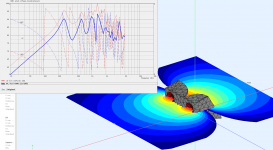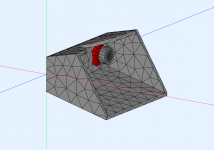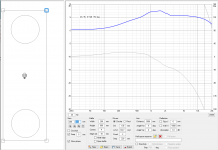I had question about OB.
Is theoretically possible to design OB speaker with U-frame and with MTM speaker element configuration in way that it goes down in -3dB point to about 100-150 Hz, had narrow front panel and is missing dipole peaks and minimums in range 100-1000 Hz?
I mean can asymmetric U-frame rear part help to avoid dipole peaks and minimums? Or at least to get smaller peaks and minimums?
I had made some simulations in Akabak with asymmetric real part U-frame, but still all had big peaks and minimums, nearly independently how asymmetric rear part of U-frame is.
Did I want impossible thing or still is some way to get rid of peaks with asymmetry?
Is theoretically possible to design OB speaker with U-frame and with MTM speaker element configuration in way that it goes down in -3dB point to about 100-150 Hz, had narrow front panel and is missing dipole peaks and minimums in range 100-1000 Hz?
I mean can asymmetric U-frame rear part help to avoid dipole peaks and minimums? Or at least to get smaller peaks and minimums?
I had made some simulations in Akabak with asymmetric real part U-frame, but still all had big peaks and minimums, nearly independently how asymmetric rear part of U-frame is.
Did I want impossible thing or still is some way to get rid of peaks with asymmetry?
Attachments
Yes, the most common way is to have a varying distance between the speaker and baffle edge. It's about spreading the diffractions.Did I want impossible thing or still is some way to get rid of peaks with asymmetry?
Diffraction doesn't have to make a significant difference to the response in order to be audible making it difficult to make judgements that way, as it has other properties.
That would depend on your definition of diffraction. Also, I'm not defining the baffle as the front panel only.Front panel diffraction contribute relatively little in 100-1000 Hz range.
Last edited:
I think first, to try to answer that, it's necessary to know whether it's important to you to have some degree of symmetry in the polar response.
I think higher priority is flat on axis response than symmetry in the polar response if to get both is not possible.
In Phoenix dipole peaks and minimums are not eliminated with special baffle shape nearly at all..
Correction is made with analog filters/EQ: Electro-acoustic models and Crossover/EQ
Additional challenge in my case is lower -3dB point at 100-150 Hz, what need bigger/deeper panel and increase peaks and minimums.
Correction is made with analog filters/EQ: Electro-acoustic models and Crossover/EQ
Additional challenge in my case is lower -3dB point at 100-150 Hz, what need bigger/deeper panel and increase peaks and minimums.
Last edited:
When you said peaks and minimums I thought you meant the ripple. That can be smoothed with a rectangular baffle.
Yes, you called them dipole peaks and minimums. Are you sure that's what they are?
I suppose a simulation might make them extreme?
I suppose a simulation might make them extreme?
Last edited:
Look image in my first post. I not call 12 dB difference between peaks and minimums as ripple.
What is mic distance in your AKABAK sim? Obviously very close to baffle. Your VituixCAD sim is at 3m and closed box!
Dual transducers will always have huge interfereces above certain F, and messed off-axis radiation.
Your idea of asymemetric box with open back doesn't help above dipole on-axis peak anyway. Nor does any other trick. Only a multiway system with gradually diminishing baffle dimensions will help you, sorry.
On Akabak simulation measurement point is 1 m from font panel.
I made VituixCAD simulation for closed box to get only from panel part of diffraction.
Dipole peaks and minimums are not diffraction, they are OB dipole front and rear part radiation summaries. Peaks are get when front and rear are in same phase in measurement point, minimums when in opposite phase. Example here Electro-acoustic models
I made VituixCAD simulation for closed box to get only from panel part of diffraction.
Dipole peaks and minimums are not diffraction, they are OB dipole front and rear part radiation summaries. Peaks are get when front and rear are in same phase in measurement point, minimums when in opposite phase. Example here Electro-acoustic models
Why it is not possible? Had you any reference to this information from some publicly available source?Your idea of asymemetric box with open back doesn't help above dipole on-axis peak anyway. Nor does any other trick. Only a multiway system with gradually diminishing baffle dimensions will help you, sorry.
My simulations show nearly same, but what is theory behind this?
It's collected info with some own tests. U-frame dipoles or any with sort of box will have more reflections in upper band than flat baffles. Unsymmetrical walls will modify that a little, but just that. And directivity is a mess above first dipole peak too. Double drivers makes it even more dramatic.
DIY-dipole-1
H frame/ Dipole/U frame ????????
H-U frame woofers
Subwoofer Origami
Cardioid bass
etc.
DIY-dipole-1
H frame/ Dipole/U frame ????????
H-U frame woofers
Subwoofer Origami
Cardioid bass
etc.
Dipole peaks and minimums are not diffraction, they are OB dipole front and rear part radiation summaries.
Yes, due to diffractions, why complicate the issue? What you've shown in your link is for two monopoles separated by a certain distance.
Last edited:
If baffle is U-frame, this makes same as two monopoles separated with U-frame depth.Yes, due to diffractions, why complicate the issue? What you've shown in your link is for two monopoles separated by a certain distance.
- Home
- Loudspeakers
- Multi-Way
- Open baffle MTM questions


